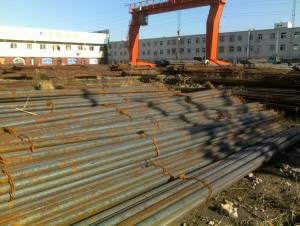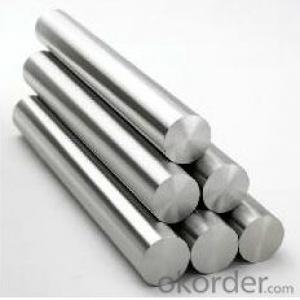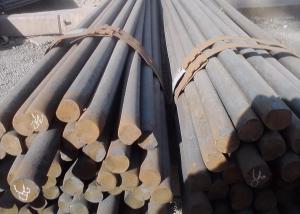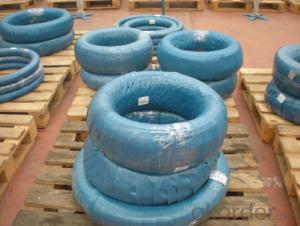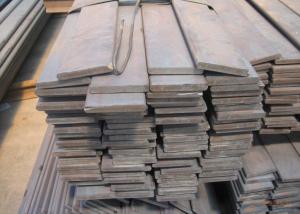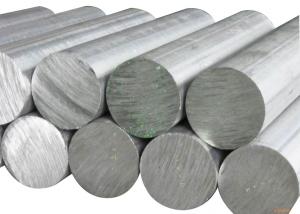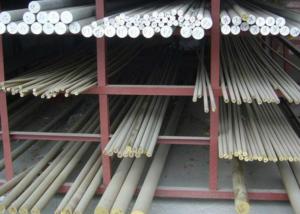Special Steel Reinforcing Steel Bars HRB400 Rebars
- Loading Port:
- China main port
- Payment Terms:
- TT OR LC
- Min Order Qty:
- 30 m.t.
- Supply Capability:
- 10000 m.t./month
OKorder Service Pledge
OKorder Financial Service
You Might Also Like
Item specifice
Product Information
1.Specification
Diameter(mm) | Φ6 ,Φ8,Φ10,Φ12,Φ13,Φ14,Φ16,Φ18,Φ20,Φ22,Φ25,Φ28,Φ32,Φ36,Φ40,Φ50 |
Length(m) | Unfolded / Straight Bundles weighing upto 2 Metric Tons and lengths is 6 Meters up to 15 Meters or according customers require |
U Shaped folded Bundles weighing up to 2 Metric Tons and lengths is 12 Meters | |
Rounded Coils ~ up to 2 Metric Ton Coils for Bending / Cutting Machine use. | |
Standard | GB(HRB335/HRB400/HRB500); |
BS4449 -1997 GRADE 250B, 460B; BS4449-2005 GRADE 500B; | |
ASTM A615 GRADE 40,GRADE60,GRADE75; ASTM A706; | |
DIN488-1 420S/500S, BST500S | |
JIS G3112 SD35, SD40, SD50,SD390 | |
NFA 35016 FE E 400, FE E 500 | |
CA 50/60 | |
GOST A3 R A500C | |
Surface finished | Screw-thread |
Epoxy coating | |
Galvanized coating | |
Production facility | Imports of production equipment from Italy |
Production capacity | 50,000 MT/month |
Payment term | T/T or 100% L/C at sight |
Package | In bundles. One bundles about 2-3tons |
2.Chemical composition
Grade | Technical data of the original chemical composition (%) | |||||
C | Mn | Si | S | P | V | |
HRB400 | ≤0.25 | ≤1.60 | ≤0.80 | ≤0.045 | ≤0.045 | 0.04-0.12 |
Physics capability | ||||||
Yield Strength (N/cm2) | Tensile Strength (N/cm2) | Elongation (%)
| ||||
≥400 | ≥570 | ≥14 | ||||
3.Theorectical weight
Diameter (MM) | Cross Sectional Area (MM2) | Theorectical Weight (KG/M) | Weight of 12M Bar (KG) | A Ton Contains 12M Bars (PCS) |
6 | 28.27 | 0.222 | 2.664 | 375.38 |
8 | 50.27 | 0.395 | 4.74 | 210.97 |
10 | 78.54 | 0.617 | 7.404 | 135.06 |
12 | 113.1 | 0.888 | 10.656 | 93.84 |
14 | 153.9 | 1.21 | 14.52 | 68.87 |
16 | 201.1 | 1.58 | 18.96 | 52.74 |
18 | 254.5 | 2 | 24 | 41.67 |
20 | 314.2 | 2.47 | 29.64 | 33.74 |
22 | 380.1 | 2.98 | 35.76 | 27.96 |
25 | 490.9 | 3.85 | 46.2 | 21.65 |
28 | 615.8 | 4.83 | 57.96 | 17.25 |
32 | 804.2 | 6.31 | 75.72 | 13.21 |
36 | 1018 | 7.99 | 98.88 | 10.43 |
40 | 1257 | 9.87 | 118.44 | 8.44 |
Product Show

Workshop Show

Shipping
1. FedEx/DHL/UPS/TNT for samples, Door-to-Door;
2. By Air or by Sea for batch goods, for FCL; Airport/ Port receiving;
3. Customers specifying freight forwarders or negotiable shipping methods!
Delivery Time: 3-7 days for samples; 5-25 days for batch goods.
Payment Terms
1.Payment: T/T, L/C, Western Union, MoneyGram,PayPal; 30% deposits; 70% balance before delivery.
2.MOQ: 1pcs
3.Warranty : 3 years
4.Package Informations: 1) EXPORT, In 20 feet (GW 25 ton) or 40 feet Container (GW 25 ton)
2)as customer's requirement
Why choose us?
(1) The leading exporter in China special steel industry.
(2) Large stocks for various sizes, fast delivery date.
(3) Good business relationship with China famous factories.
(4) More than 7 years steel exporting experience.
(5) Good after-sales service guarantee.
- Q:How does special steel contribute to the manufacturing of cutting tools?
- Due to its unique properties and characteristics, special steel plays a crucial role in the manufacturing of cutting tools. Tool steel, also known as special steel, exhibits high hardness, enabling it to withstand the tremendous forces and stress exerted during cutting operations, preventing quick deformation or wear of the cutting tools and ensuring their longevity and efficiency. In addition, special steel possesses excellent wear resistance, minimizing the wear and tear on the tools subjected to constant friction and abrasion. This improves the tool's lifespan, reducing the need for frequent replacements and enhancing cost-effectiveness in the manufacturing process. Furthermore, special steel offers superior heat resistance, maintaining its hardness and integrity even under high temperatures. This allows cutting tools to perform consistently and precisely, even in extreme heat conditions, preventing thermal degradation and loss of hardness. Moreover, special steel used in cutting tool manufacturing exhibits excellent toughness and strength, enabling the tools to endure heavy loads and impacts without fracturing or chipping. The combination of hardness, wear resistance, heat resistance, toughness, and strength provided by special steel ensures the durability and reliability of cutting tools, allowing them to perform efficiently and accurately. Overall, special steel significantly contributes to the manufacturing of cutting tools, providing the necessary properties to withstand demanding cutting conditions. Its high hardness, wear resistance, heat resistance, toughness, and strength ensure that cutting tools remain sharp, durable, and efficient, enhancing productivity and precision in various industries, including automotive, aerospace, and manufacturing.
- Q:How does special steel contribute to the hardness of products?
- The hardness of products is enhanced by special steel due to its distinct composition and manufacturing techniques. Unlike regular steel, special steel is mixed with additional elements like chromium, nickel, and manganese, which bolster its strength and durability. These alloying elements combine with the steel matrix to form solid solutions, resulting in a more rigid and compact structure. The inclusion of these alloying elements in special steel allows for the creation of diverse microstructures, including fine-grained structures and martensitic structures, which significantly increase the steel's hardness. Moreover, special steel often undergoes heat treatment processes such as quenching and tempering, which further refine its microstructure and enhance its hardness. Furthermore, the hardness of special steel can also be influenced by the manufacturing processes employed, such as hot rolling or cold working. These processes deform the steel, align its grain structure, and minimize any defects or impurities, resulting in a more uniform and harder material. The hardness of special steel plays a vital role in various industries where strength, wear resistance, and resistance to deformation are crucial. For instance, in the automotive industry, special steel is utilized in the production of engine parts, gears, and axles, all of which require high hardness to withstand challenging conditions and loads. Similarly, in the construction industry, special steel is used for manufacturing tools, cutting blades, and reinforcement bars, where hardness is essential for longevity and performance. In conclusion, special steel's contribution to product hardness is attributed to its unique alloying elements, manufacturing techniques, and heat treatments. Its ability to form various microstructures and its resistance to deformation make it an excellent material for applications where hardness is vital for performance and durability.
- Q:How does special steel contribute to the ductility of products?
- Special steel contributes to the ductility of products by offering enhanced mechanical properties such as higher tensile strength and improved toughness. This type of steel is specially formulated with alloying elements that promote grain refinement and uniform microstructure, allowing the material to withstand greater deformation without breaking or cracking. Additionally, special steel often undergoes specific heat treatment processes that further enhance its ductility, ensuring that the final products can be easily shaped, bent, or stretched without compromising their structural integrity.
- Q:How is special steel used in the aerospace industry?
- Special steel is used in the aerospace industry for various applications due to its exceptional strength, durability, and resistance to extreme temperatures. It is commonly utilized in the manufacturing of aircraft structures, engine components, landing gear, and fasteners. The high strength-to-weight ratio of special steel enables the construction of lightweight yet robust parts, contributing to improved fuel efficiency and aircraft performance. Additionally, its ability to withstand harsh environmental conditions and maintain structural integrity makes it indispensable for ensuring the safety and reliability of aerospace systems.
- Q:What are the requirements for special steel used in cryogenic applications?
- Special steel used in cryogenic applications must meet several requirements to ensure its performance and reliability in extreme low-temperature environments. Firstly, the steel should have excellent low-temperature toughness to withstand the extreme cold. This means that it should be able to resist brittle fracture and maintain its mechanical properties even at cryogenic temperatures. The steel should have a high toughness and ductility to absorb impact and prevent cracking. Secondly, the steel must have a low coefficient of thermal expansion. This is important because cryogenic applications involve significant temperature changes, and a high coefficient of thermal expansion can lead to dimensional instability and stress within the material. A low coefficient of thermal expansion helps to minimize these effects and maintain dimensional stability. Thirdly, the steel should have a low thermal conductivity. Cryogenic applications often involve the transfer or storage of extremely cold substances, and a low thermal conductivity helps to prevent heat transfer and maintain the desired temperature. This is particularly important for applications where temperature control is critical, such as in the storage of liquefied gases. Additionally, the steel should have good corrosion resistance. Cryogenic environments can be highly corrosive, and the steel needs to be able to withstand the effects of any corrosive substances that may be present. This is particularly important for applications involving the storage or transportation of cryogenic liquids or gases. Finally, the steel should have good weldability. In many cryogenic applications, welding is required to join different components or sections of the steel. Therefore, the steel must have good weldability to ensure strong and reliable joints. In summary, the requirements for special steel used in cryogenic applications include excellent low-temperature toughness, low coefficient of thermal expansion, low thermal conductivity, good corrosion resistance, and good weldability. Meeting these requirements ensures that the steel can withstand the extreme cold and harsh conditions of cryogenic environments while maintaining its structural integrity and performance.
- Q:How does special steel contribute to the manufacturing of springs for automotive applications?
- Special steel is crucial for the manufacturing of springs in automotive applications because it offers high strength, durability, and excellent fatigue resistance. It allows springs to withstand heavy loads, vibrations, and extreme temperatures while maintaining their shape and performance over time. Special steel also provides flexibility in design, allowing for the production of springs with specific characteristics such as improved stability, reduced weight, and enhanced energy absorption. Overall, the use of special steel in spring manufacturing ensures reliable and efficient performance in automotive applications.
- Q:What are the different international trade regulations for special steel?
- Special steel, which is produced for specific applications or industries, falls under the purview of various international trade regulations. These regulations have the objectives of ensuring fair trade practices, protecting domestic industries, and promoting safety standards. The World Trade Organization (WTO) agreements are one of the primary international trade regulations for special steel. The WTO, through agreements like the General Agreement on Tariffs and Trade (GATT) and the Agreement on Safeguards, establishes rules for global trade. These agreements address issues such as tariffs, non-tariff barriers, and safeguard measures that may be imposed on imports of special steel. Another significant regulation is the Harmonized System (HS) codes. These codes provide a standardized system of names and numbers to classify traded products. Special steel is assigned specific HS codes, which enable customs authorities to determine the relevant duties and regulations applicable to these products during import or export. Regional trade agreements (RTAs) also play a role in regulating international trade of special steel. RTAs are agreements between countries or regions that aim to reduce trade barriers and promote economic integration. Examples of such agreements include NAFTA, the EU, and the CPTPP. They often include provisions related to tariffs, technical standards, and trade facilitation for special steel. Furthermore, certain countries may have specific regulations concerning the import or export of special steel. These regulations may encompass licensing requirements, quality standards, safety certifications, or restrictions on certain types of steel. Businesses involved in the trade of special steel must be aware of these country-specific regulations to ensure compliance. In conclusion, the regulations governing international trade of special steel encompass a variety of agreements, codes, and country-specific rules. Adhering to these regulations is crucial for companies engaged in global trade to ensure compliance, avoid penalties, and uphold fair trade practices.
- Q:What are the applications of special steel in the nuclear industry?
- Special steel is extensively used in the nuclear industry due to its unique properties. It is used to manufacture various components such as reactor vessels, steam generators, and fuel cladding, which require high strength, corrosion resistance, and heat resistance. Special steel ensures the safety and efficiency of nuclear power plants by withstanding extreme temperatures, pressures, and corrosive environments. Its applications in the nuclear industry are crucial for maintaining the integrity and reliability of nuclear facilities.
- Q:Can special steel be used in the manufacturing industry?
- Yes, special steel can be used in the manufacturing industry. Special steel refers to specific types of steel that have been tailored to possess certain properties, such as increased strength, improved corrosion resistance, or superior heat resistance. These specialized properties make special steel ideal for various applications in the manufacturing industry, including the production of heavy machinery, automotive parts, tools, and construction materials.
- Q:What are the different methods of surface peening for special steel?
- To enhance the mechanical properties of special steels, surface peening is employed to induce compressive stresses on the surface. This process helps improve fatigue life, resistance to stress corrosion cracking, and overall durability. Various methods of surface peening exist for special steel, including: 1. Shot Peening: This technique involves bombarding the steel surface with high-velocity spherical particles, known as shot. The impact of these particles induces plastic deformation and creates compressive stresses. Shot peening is widely used due to its effectiveness in improving fatigue life. 2. Ultrasonic Peening: Compressive stresses are induced on the steel surface using high-frequency vibrations in ultrasonic peening. These vibrations are applied through a tool in contact with the surface, leading to plastic deformation and the generation of compressive stresses. 3. Laser Peening: A high-energy laser beam is utilized in laser peening to create shockwaves on the steel surface. These shockwaves induce plastic deformation and generate compressive stresses. Laser peening is known for its precision and ability to target specific areas. 4. Cavitation Peening: By creating cavitation bubbles near the steel surface in a liquid medium, cavitation peening induces compressive stresses. The collapse of these bubbles generates high-intensity shockwaves. This method is particularly beneficial for irregularly shaped components. 5. Needle Peening: In needle peening, a bundle of fine needles is repeatedly impacted on the steel surface. This process induces plastic deformation and generates compressive stresses. Needle peening is commonly used for localized treatment of small areas. Each of these methods offers unique advantages and is suitable for specific applications. The selection of the surface peening method depends on factors like the type of special steel, component geometry, desired improvements, and available equipment. It is crucial to consider the specific requirements and seek expert advice to determine the most appropriate method for surface peening special steel.
1. Manufacturer Overview |
|
|---|---|
| Location | |
| Year Established | |
| Annual Output Value | |
| Main Markets | |
| Company Certifications | |
2. Manufacturer Certificates |
|
|---|---|
| a) Certification Name | |
| Range | |
| Reference | |
| Validity Period | |
3. Manufacturer Capability |
|
|---|---|
| a)Trade Capacity | |
| Nearest Port | |
| Export Percentage | |
| No.of Employees in Trade Department | |
| Language Spoken: | |
| b)Factory Information | |
| Factory Size: | |
| No. of Production Lines | |
| Contract Manufacturing | |
| Product Price Range | |
Send your message to us
Special Steel Reinforcing Steel Bars HRB400 Rebars
- Loading Port:
- China main port
- Payment Terms:
- TT OR LC
- Min Order Qty:
- 30 m.t.
- Supply Capability:
- 10000 m.t./month
OKorder Service Pledge
OKorder Financial Service
Similar products
New products
Hot products
Related keywords
